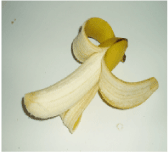Element:BSVAV
DescriptionBanana streak virus (BSV), the causal agent of viral "leaf streak disease" of banana and plantain (Musa spp.) (Lockhart, 1986), is a member of the plant pararetrovirus genus Badnavirus of Caulimoviridae family (International Committee on the Taxonomy of Viruses -ICTV- Fauquet et al. 2005). Several isolated have been studied, one of which is BSVaV infecting Musa acuminata siamea species (A genome) from Vietnam (Lheureux et al. 2007). According to Llorens et al. 2009, BSVaV belongs to Badnavirus genus within Class 2 of the Caulimoviridae family. BSVaV has bacilliform-shaped virions and a 7801 bp long circular dsDNA genome containing three open reading frames (ORFs I, II, III). Unlike the other BSV species, BSVaV has no overlapping ORFs. According to the Badnavirus genome structure, BSVaV also potentially encode for a virion associated protein (VAP) (ORF I), for an unknown protein with a molecular weight of 14.4 kDa (ORF II) and for a polyprotein showing motifs related to the movement protein (MOV), RNA binding (COAT-gag), aspartate protease (PR), reverse transcriptase (RT) and ribonuclease H (RH) (ORF III). ORF I and ORF II are separated by 92 nt, wheras ORF II and ORF III are divided by only one codon. As observed in the genome of BSMyV, BSVaV-ORF I has also a non-conventional start codon (Lheureux et al. 2007). The gag-like region includes a large region (only observed in Badna- and Tungroviruses), which is rich in zinc finger (CCHC) array duplications similarly to those of several LTR retroelement nucleocapsids (Hull 1996; Bouhida et al. 1993; Llorens et al. 2009). The viral "leaf streak disease" was first described in Ivory Coast, Africa in 1968 (Lassoudiere 1974), but now is probably distributed worldwide in cultivated banana and plantain crops. The symptoms are correlated with variations in virus concentration and may vary from faint broken chlorotic lines to necrosis of young leaves, internal necrosis of the pseudostem and plant death. The bunch size and fruit quality are also compromised (Lockhart, 1986). The virus is transmitted naturally by the two mealybug vectors (Pseudococcidae) Planococcus citri and Saccharicoccus sacchari (both of which colonize banana), as well as by seed, even if the vegetative propagation is the principal method of virus spread. The ability of P. citri to act as a vector of BSVaV has been demonstrated (Lheureux et al. 2007). Unlike the petuvirus Petunia vein clearing virus (PVCV, Richert-Pöggeler and Shepherd 1997), no obvious integrase motif could be identified in the BSV sequence (Harper and Hull 1998). However, multiple DNA sequences (Endogenous pararetrovirus, EPRV) related to the virus are found integrated into the nuclear genome of different Musa cvv. (Harper et al. 1999; Ndowora et al. 1999; Geering et al. 2005 Gayral et al. 2008; Gayral and Iskra-Caruana 2009). Two types of BSV-EPRV sequences have been described in banana genome. The first type sequences, defined as noninfectious (with nonfunctional viral ORFs and/or incomplete viral genomes), are present in the two most common Musa species Musa acuminata (denoted A) and Musa balbisiana (denoted B) that, together to Musa schizocarpa (denoted S) are the wild progenitors of the domesticated banana (Geering et al. 2005). The second EPRV sequences, so-called infectious type, contain the complete functional viral genome and have been detected in some Musa genotypes (i.e AAB and BB groups, Geering et al. 2005; Gayral et al. 2008). The increasing of BSV outbreaks observed among banana breeding lines and micro-propagated interspecific Musa hybrids has been mainly linked to the presence of integrated sequences in M. balbisiana genome (B) that, under stress conditions, could become infectious by reconstituting a complete replication competent viral genome (Dallot et al. 2001; Harper et al. 1999; Ndowora et al. 1999; Lheureux et al. 2003). The presence of BSVaV-integrated sequences in Musa genotypes has been studied (Lheureux et al. 2007). No BSVaV-EPRVs have been isolated from any analized M. balbisiana genotypes, whereas partial sequences have been observed in several M. acuminata and interspecies genotypes indicating that BSVaV-EPRVs are restricted to the genotype A (Lheureux et al. 2007). Structure
Related literature |
|
|||||||||||||||||||||||||||||||||||||||||


